Aboriginal artworks
Providing Aboriginal artworks at Perth Children’s Hospital brings a sense of pride in Aboriginal culture and a connection to Country, whilst providing comfort to our Aboriginal patients and families. There are over 50 Aboriginal artworks on display throughout the hospital, located in public and clinical spaces, as well as corporate areas.
Staff, patients, families and visitors are encouraged to discover the many Aboriginal artworks on display at the hospital as an opportunity to celebrate and understand Aboriginal culture.
Download the Aboriginal artworks tour flyer (PDF 2.3MB)
1. Koolung Wunjuning Kulark Wunjoo (Children Healing Place Welcome)
Level 1, Yellow lifts
Aboriginal Welcome Artwork: Koolung Wunjuning Kulark Wunjoo (Children Healing Place Welcome), 2013 by Richard Walley, Olman Walley and John Walley
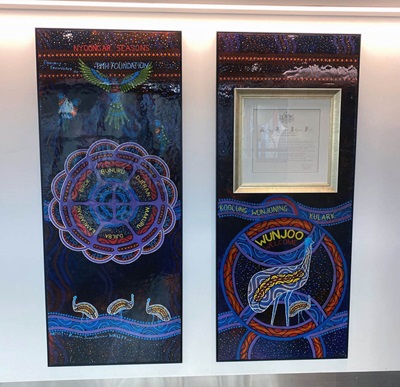
The artwork bears the 2007 Federal Governments official Apology to Australia’s Indigenous Peoples.
The Aboriginal Welcome Artwork was created by Richard, John and Olman Walley in 2013 at Princess Margaret Hospital. The artists involved patients from PMH wards 7Teen (adolescents) and 3B (Oncology) wards in the creation of this artwork.
The artwork features the words - Koolung Wunjuning Kulark Wunjoo which translates to mean, Children Healing Place Welcome.
There is a large emu depicted with emu chicks. The emu is a significant animal to the Aboriginal people. It possesses the most powerful healing properties. The emu also cares for its young, interestingly it is the father who takes on this role. The emu can be seen to represent both healing and nuture, making it a fitting image for the Aboriginal Welcome.
There is also a mandala styled calender for the Noongah Seasons featured. This pays homage to the Noongah people by depicting the six Noongah seasons: Birok, Bunuru, Djeran, Makuru, Djilba and Kambarang around the four Western seasons of Summer, Autumn, Winter and Spring and also surrounded by the 12 months of the year.
2. Story About a Billabong
Ward 3 entrance
Story About a Billabong, 1990 by Joyce Gumbarraway
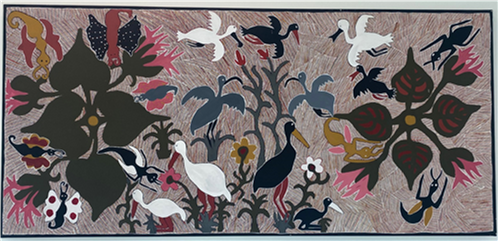
The artwork Story About a Billabong, 1990 was painted by Joyce Gumbarraway, an Aboriginal artist from the Galiwinku community in Elcho Islands in the Northern Territory.
The traditional “Rarrk” or cross-hatched patterned fine line artwork is a feature of Arnhem Land paintings and is traditionally painted onto bark or body for traditional cultural ceremonies, however the community elders became concerned and aware that should the practice of bark painting continue, no trees would be left for future generations.
The adaptation of this style of painting onto stretched canvas, referred to as “White Man’s Bark”, provides a contemporary expression of traditional knowledge that can be used as an educational tool for greater understanding and awareness of these ancient people.
The artwork is painted in natural ochre acrylic paint and depicts the indigenous flora and fauna of the area, including water lilies, birds, bats, beetles and flying ants.
The artwork was donated by Des and Virginia Brennan who worked and lived on Elcho Island and were employed to assist the Yolngu people in realising their dream of a wider audience in the public domain and understanding of ancient people.
3. Chirriger Nanap (Blue Wren Braking)
Level 1, Pink Lifts
Chirriger Nanap (Blue Wren Braking), 2017 by Peter Farmer Snr
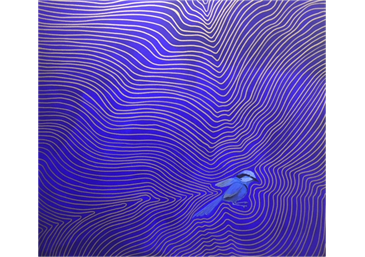
Peter Farmer Snr is a Noongar artist born in the Great Southern in Gnowangerup in 1971. Farmer’s family descend from a number of Noongar groups including the Whadjuk, Minang, Wilman and Wardandi peoples.
Farmer lived at Marribank Mission between the ages of 8 and 17. Marribank was previously the Carrolup Native Settlement renowned for the artworks created by the Carrolup children.
In 1999, he enrolled in an Associate Degree in Contemporary Aboriginal Art at Curtin University, and went on to complete a Bachelor of Arts (Visual Arts) in 2001. In 2008, Farmer was named Visual Artist of the Year at the Perth NAIDOC Awards.
Peter Farmer Senior's totem is the Chirriger (Blue Wren).
"Whilst watching my totems movement sometimes, he is much too graceful for us land-dwellers. How could this fellow move to brake with such ease? But then realised that I do this also, metaphorically speaking; having the innate ability to change directions, and to slow things down in life when there is a need to.
Chirriger Nanap (Blue Wren Braking) helps me visualise how it can be done with patience, precision and some decorum."
- Peter Farmer II, 2018
This artwork was purchased with funds raised through the sale of artworks deaccessioned from Princess Margaret Hospital for the ongoing enjoyment of patients, families and staff at PCH.
4. Kulbardi Bidi (Magpie Paths)
Level 1, Pink Lifts
Kulbardi Bidi (Magpie Paths), 2018 by Peter Farmer Jnr
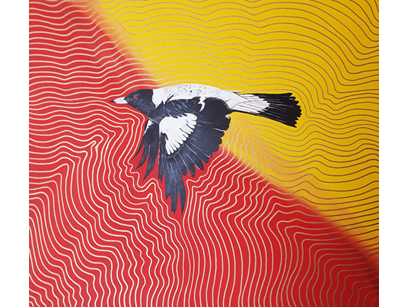
Peter Farmer Jnr is the first Minang Man in his family to not be born in Minang country (Albany or Gnowangerup). His mother being Ballardong and his father Minang, he claims connections through his paternal grandmother’s country “Wadjuk”, through birth.
Peter Farmer Jnr studied Fine Arts at Deakin University and Curtin University and has been encouraged through the guidance and experience of his father to complete various artwork commissions and ambitious initiatives, alongside continuing his passion for playing professional football.
"Sometimes it isn’t the actual place that we had intended to go; but more the journey or paths that we take to get there.
Most times in people’s healing journey’s it is the unexpected that yields the most surprises and often happiness at reaching the other side.
I have painted a strong Noongar Totem in the Kulbardi that is representative of protection and guardianship for the young and sick. And on this particular artwork he is on many pathways which hopefully lead us to where we’d like to go."
- Peter Farmer III, 2018
This artwork was purchased with funds raised through the sale of artworks deaccessioned from Princess Margaret Hospital for the ongoing enjoyment of patients, families and staff at PCH.
5. Maburra (Bush Tucker Place)
Level 5, Board Room Corridor
Maburra (Bush Tucker Place), 1996 by Beerbee Mungnari
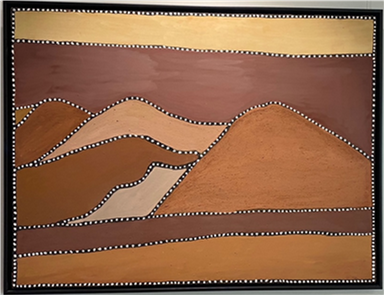
These artworks by Beerbee Mungnari (Maburra and Moonoomroon) are from the Warmun Community in the Kimberley that is owned and run by the Gija people, near Turkey Creek and the Bungle Bungles. The Warmun centre was established in 1998 by the late founding members of the contemporary Aboriginal painting movement including Rover Thomas, Queenie McKenzie and Jack Britten and is well known for its Ochre paintings representing country.
Beerbee Mungnari was born at Waterloo Station, Northern Territory in 1933 and he has lived and worked most of his life as a stockman, working on various stations in the East Kimberley region.
He grew up at Rosewood Station and went to work at 16 years of age, on Texas Downs Station where the workers would often spend evenings carving boab nuts with a sharp piece of wire or blade. They would carve turkeys, emus, snakes and crocodiles on the nuts.
Mungnari has many stories of the country south and east of Kununurra before Argyle Dam was built including the cattle drives that he worked on that form the basis for Mungnari's paintings.
Mungnari started to paint in 1982, the same year that the school at Warmun started and spent a lot of time painting the early stories to teach students at the new Ngalanganpum School. His early works now form part of the Warmun Community Collection.
Mungnari used to watch old Jack Britten paint and started to experiment with ochre himself and learn techniques from some of the early Warmun painters. His interest and love of the country was and still is the major influence for his landscapes.
6. Moonoomroon
Level 5, Board Room Corridor
Moonoomroon, 1996 by Beerbee Mungnari
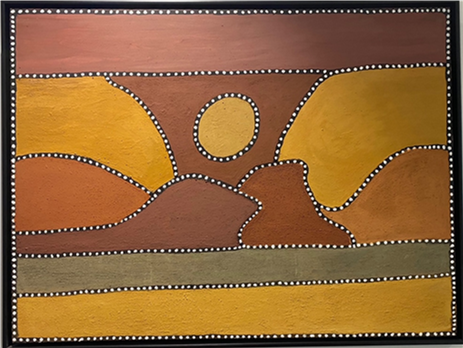
These artworks by Beerbee Mungnari (Maburra and Moonoomroon) are from the Warmun Community in the Kimberley that is owned and run by the Gija people, near Turkey Creek and the Bungle Bungles. The Warmun centre was established in 1998 by the late founding members of the contemporary Aboriginal painting movement including Rover Thomas, Queenie McKenzie and Jack Britten and is well known for its Ochre paintings representing country.
Beerbee Mungnari was born at Waterloo Station, Northern Territory in 1933 and he has lived and worked most of his life as a stockman, working on various stations in the East Kimberley region.
He grew up at Rosewood Station and went to work at 16 years of age, on Texas Downs Station where the workers would often spend evenings carving boab nuts with a sharp piece of wire or blade. They would carve turkeys, emus, snakes and crocodiles on the nuts.
Mungnari has many stories of the country south and east of Kununurra before Argyle Dam was built including the cattle drives that he worked on that form the basis for Mungnari's paintings.
Mungnari started to paint in 1982, the same year that the school at Warmun started and spent a lot of time painting the early stories to teach students at the new Ngalanganpum School. His early works now form part of the Warmun Community Collection.
Mungnari used to watch old Jack Britten paint and started to experiment with ochre himself and learn techniques from some of the early Warmun painters. His interest and love of the country was and still is the major influence for his landscapes.
7. Women Who Hunted Meat
Level 5, Board Room Corridor
Women Who Hunted Meat, 1992 by Ron Corbett
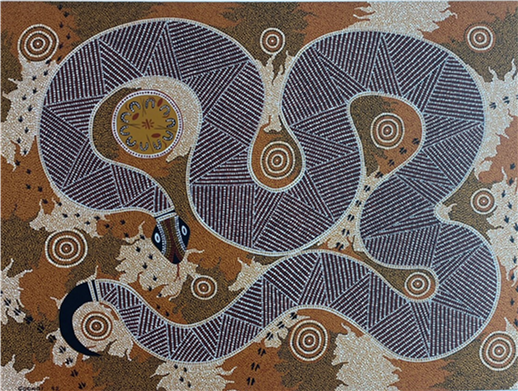
Ron Corbett is from Carnarvon and the Yamitji people.
The snake in his traditional ochre-coloured painting is known in the Pilbara-Kimberley region as the sacred water python. It watches over the water holes keeping them clean and thus sustaining animal and human life. Kill the snake and it will dry up the water as punishment.
The artwork depicts the aboriginal symbols for animal tracks, meeting places and waterholes.
8. Awelye
Level 5, Board Room Corridor
Awelye, 1996 by Jeanie Petyarre
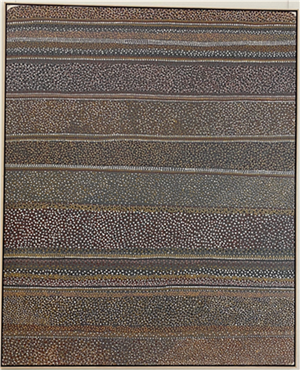
Jeannie was born c. 1951 at Boundary Bore Outstation in the Utopia region of the Northern Territory.
She is of the Petyarre (Pitjara) Skin Group and her language is Anmatyerre.
Jeannie is a member of one of the best known Australian artistic families and her cousins are the very famous Petyarre sisters Kathleen, Gloria, Violet, Ada Bird (deceased), Myrtle and Nancy (deceased).
She was encouraged to paint by her aunt, Emily Kame Kngwarreye (deceased), the best known of the female Desert artists.
Her close relationship with these painters allows Jeannie to paint the Dreamings of the Utopia people, including Awelye (body paint) and Yam Dreaming, which she paints with meticulously in a traditional approach.
9. Awelye
Level 5 Pink Lifts
Awelye, 2019 by Charmaine Pwerle
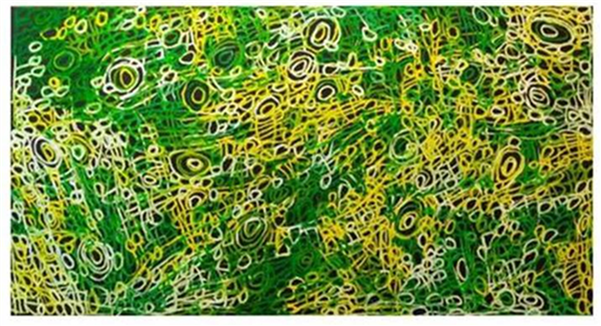
This artwork was commissioned by BP for their Centenary celebrations in 2019 and is on long term loan to Perth Children’s Hospital.
Charmaine Pwerle is from the Utopia region in Central Australia and comes from a family with rich artistic talent. Her grandmothers include Minnie Pwerle and Emily Kngwarreye, Emily being the most famous Indigenous artist from the Utopia region.
Charmaine has painted 'Awelye', or Women's Ceremony and depicts the designs applied to a women's body as part of a ceremony. Awelye is performed by Aboriginal women to recall their ancestors, to show respect for their country and to demonstrate their responsibility for the wellbeing of their community.
In Awelye, the women paint each other’s upper bodies with ochre markings, before dancing in a ceremony. The body designs are important and, painted on chest and shoulders, they relate to each particular woman’s dreaming. The ochre pigment is ground into powder form and mixed with charcoal and ash before being applied with a flat padded stick or with fingers in linear and curving patterns.
The circles in these designs represent the sites and movement where the ceremonies take place. The small and large semi-circular shapes of the piece represent Australia’s hills and valleys and the lines are that of dry riverbed and streams, winding across the canvas as they do at Utopia in the Northern Territory.
10. Djerapin
Ground Floor outside Kulunga Moort Mia
Djerapin (Happy), Kidogo Art Team
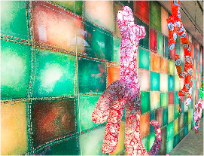
Located in the front window leading up to our main entrance, Djerapin meaning ‘happy’ in Noongar language is a contemporary artwork that speaks about WA’s incredible Aboriginal history and culture.
With five uniquely painted fibreglass dog sculptures suspended in front of a large printed glass and LED light wall. The artwork incorporates universal symbols of comfort.
The glass wall depicts stitched blankets which are nurturing and provide comfort, the dancing dogs covered in dots reference Aboriginal painting and the tracks we make as we journey from place to place.